
Finishing is a key skill in life. Everybody has a successful pattern for finishing. Sometimes it can be important to find and follow this pattern. This can help us to finish tasks, projects and even relationships.
What is your successful pattern for finishing? How can you follow this to finish things properly? How can you do this in your personal or professional life?
“Flow, focus, finish and, as a by-product, find fulfilment,” is the motto. Sounds easy in theory, but how does it work in practice? Let’s explore some of the principles for completing things successfully.
You can choose something
you want to finish successfully
Looking into the future, can you think of something you want to finish? You may want to write an article, launch a web site, move on from an employer, finish a relationship or complete another activity.
Good finishers choose to be selective to be effective. Creative people start lots of things but may only finish certain projects. It is impossible to complete everything in life.
Sometimes it can be useful to make a conscious decision and – providing you accept the consequences – it can be okay to say:
“I don’t want to finish it.”
Good finishers focus on the things they want to complete. How they aim to do this depends on what they want to finish properly.
Some people find it relatively simple to set specific goals and work to complete a task. Providing they do the job well, they get satisfaction from solving a problem, creating a product or getting a visible result.
People sometimes find it harder to manage emotional issues. They are seldom taught how to find win-win solutions to conflicts or move on from relationships in a relatively positive way.
Can you think of something you would like to finish? What would be the benefits of doing the work and reaching the goal? How would you feel? What would be the pluses – both for you and for other people? What might be the potential minuses?
Looking ahead, how motivated do you feel to do the work involved? Rate this on a scale 0-10. What can you do to increase the rating?
If you wish, try tackling the exercise on this theme. This invites you to complete the following sentences.
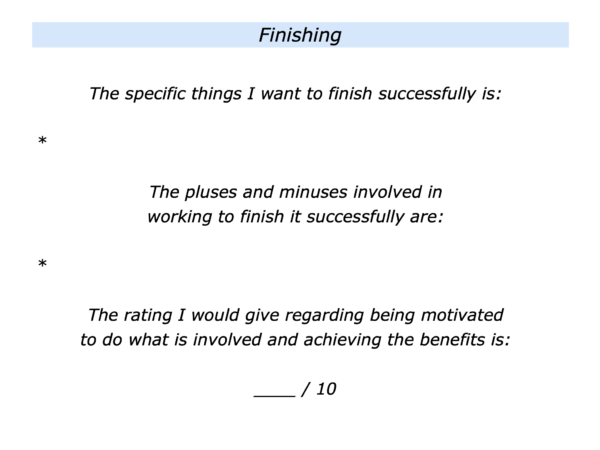
You can clarify your
successful pattern for finishing
Everybody has a positive history. Everybody has a successful pattern for finishing. Bearing this in mind, it can be useful to find and follow your successful pattern.
How to make this happen? One approach is to look back at some of the things you have finished successfully.
Some of these may be tangible things. You may have worked to pass an exam, get your driving licence, become healthier, complete a project, overcome a setback or tackle a challenge successfully.
Some of these may be less tangible but also significant. You may have given specific encouragement to a person, helped students to find work they enjoy, found win-win solutions to a conflict or ended a relationship in a relatively good way.
Looking back, what did you do right to finish some of these things successfully? What were the principles you followed? How did you translate these into action? What happened as a result?
Can you see any patterns? What were the principles you followed for finishing some of the tangible things successfully? What were those you followed for managing the emotional things in, as far as possible, a positive way?
Different people mention different things when describing their successful pattern for finishing. Here are some of the things they describe.
My Successful Pattern
For Finishing Is:
To decide if I really want to finish something … To consider the pluses and minuses involved in doing the work … To clarify the strategy I can follow to give myself the greatest chance of success.
To set aside blocks of time to do the work … To set myself achievable goals each session … To follow good habits … To get some successes along the way … To reach my goal for the session.
To keep reminding myself of the benefits … To encourage myself on the journey … To find solutions to challenges … To relax before the final push … To do my best to finish properly.
You will obviously have your own pattern. Looking ahead, what may be some of the principles you can follow in the future? You may need to add some other skills, of course, but following these principles may help you to finish things successfully.
If you wish, try tackling the exercise on this theme. This invites you to complete the following sentences.
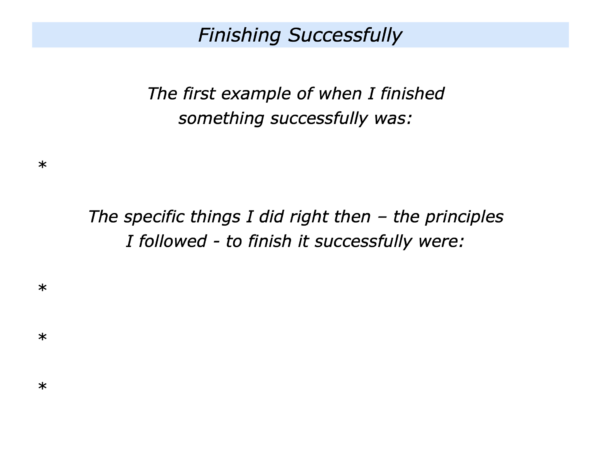
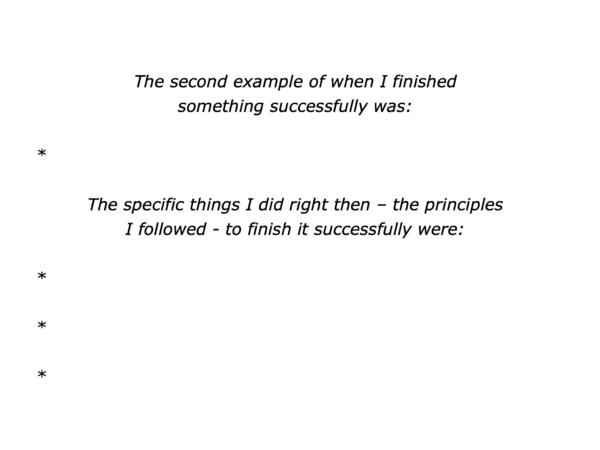
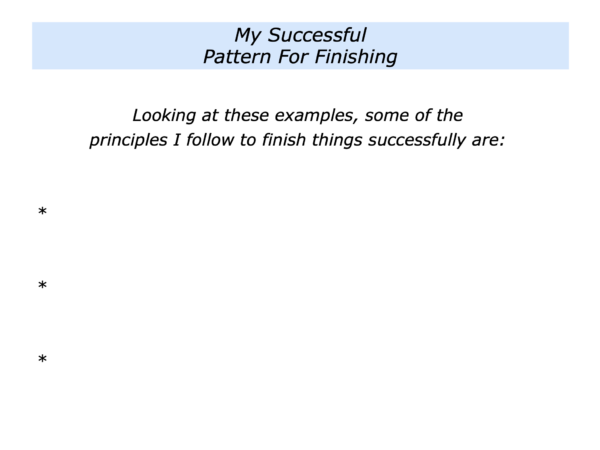
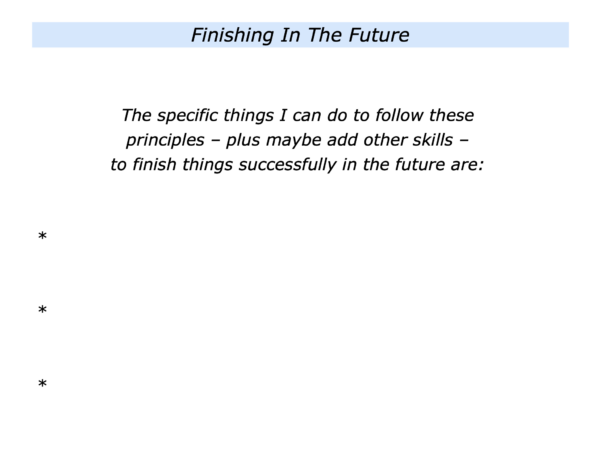
You can follow your successful pattern for
finishing and aim to flow, focus and finish
Imagine you have found your successful pattern for finishing. The next step will be to follow it in your own way.
Different people focus on different things on the way to finishing successfully. Some bear in mind the saying that has been attributed to teams in Formula 1:
In order to finish first,
first you have to finish.
The team may be gung-ho about winning the Grand Prix, but first they must do everything to complete the race. Otherwise they have no chance of winning.
This is a rule that applies in other sports and in life. Sometimes you see a football team spraying each other with champagne when they have qualified for a final.
Certainly it is important to celebrate, but the job is not yet finished. The team then needs to complete the job in the final. This highlights a rule that applies to people in many fields.
Make sure you deliver the goods.
Don’t declare victory too early.
Great workers are often good finishers in the areas where they excel. Such people embody some elements of what Daniel Kahneman called Peak-End Theory.
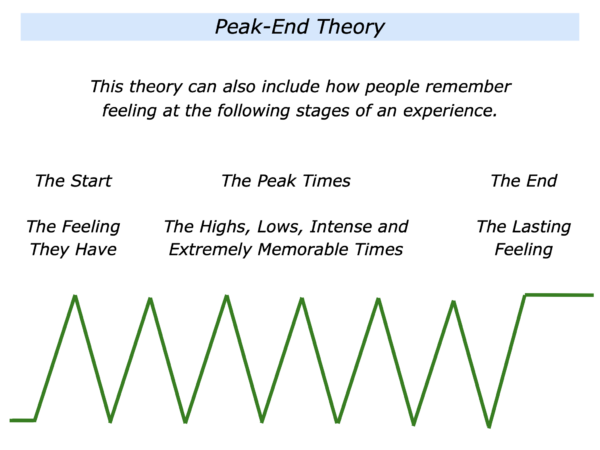
The theory says that, when looking back, people do not necessarily recall their feelings throughout an experience. Instead, they remember the way they felt at:
The peak times – the intense times – and the end of the experience.
The peak times may be pleasant or unpleasant. These are the memories that stay with us, as does the way we felt at the end of the experience.
Many people also remember how they felt at that start of an experience. For example, whether the start was welcoming, enjoyable or difficult. It is also important to finish in a positive way. This approach can be applied to how we remember, for example:
A relationship … A job we did at some point in our career … A sporting event, musical performance or other experience.
Many singers, entertainers and peak performers follow this approach. They aim to:
Start Big – Give Lots of Highs – End Big
Imagine you have taken some of these steps. Looking ahead, you may see the end in sight. Reminding yourself of the benefits, you can then aim to flow, focus and finish.
If you wish, try tackling the final exercise on this theme. This invites you to complete the following sentences.
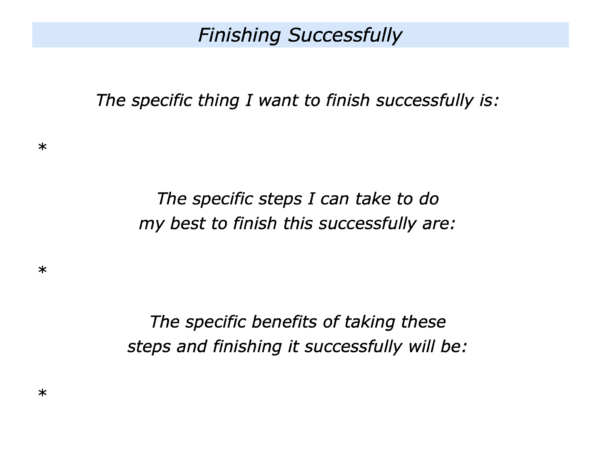






Leave a Reply